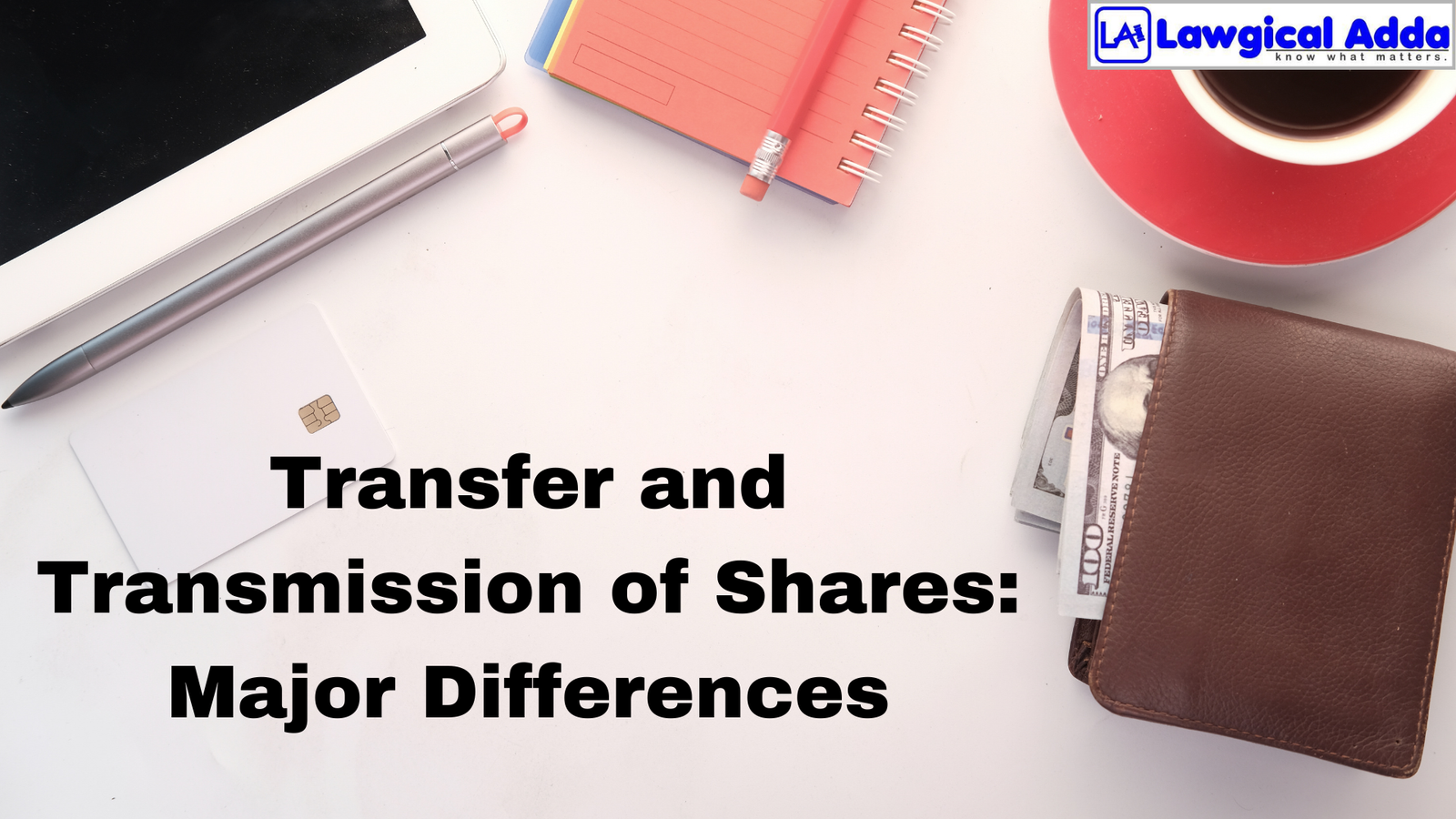Transfer and Transmission of Shares: Major Differences

Table of Contents
When a shareholder transfers their shares willingly and in accordance with a formal agreement, the shares are considered to have been transferred. Although the transfer of shares is known as “transmission of shares,” it can also happen by operation of law, in the event of a shareholder’s death, insolvency, or distinguish between transfer and transmission of shares mental illness. We shall examine the definitions of “share transfer” and “share transmission,” as well as the distinctions between the two terms in this blog.
In this article, Lawgical Adda will cover everything you need to know about the transfer and transmission of shares, highlighting the major differences.
Transfer Of Share- A Voluntary Handover
A voluntary transfer of ownership rights from one party to another occurs during a share transfer. Through this process, the recipient—also referred to as the transferee—gains the rights to the shares, while the present shareholder—also referred to as the transferor—willfully gives up ownership. In order to complete this voluntary act, a share transfer deed—a legal document that acknowledges the change in ownership—must be completed.
Why Share Transfers Occur?
Typical situations that call for the transfer of share ownership include:
- Sale Transaction: Through a share transfer deed, the original holder transfers shares to the buyer in exchange for money.
- Gifting: When a transferor gifts shares, they willingly and without payment transfer ownership of the securities to another qualified receiver via a gift deed.
- Share Lending: Lending securities against collateral also involves the temporary transfer of shares from lender to borrower as well as the share reversion at the end of the loan period.
- Transmission Errors: Technical transfers may be necessary for corrections resulting from incorrect share records under joint ownership arrangements. For example, shares between parents and children are only recorded under the grandparents, necessitating a technical transfer via the father to fix the lineage.
As a result, share transfers cover a wide range of circumstances in which one party’s legal ownership shifts to another related or unrelated entity.
Procedure for Transferring Shares
The following are the main procedural processes in a share transfer between two parties:
Step 1: Agreement between Buyer and Seller
In order to execute a contract note or gift declaration draft, the parties involved first finalize the parameters of the share transfer through a sale consideration or gift value agreement, mentioning security elements such as the quantity and face value of the shares together with the selling amount.
Step 2: Requirements for Documentation
Following agreement on the conditions of the share transfer, the necessary regulatory application paperwork must be filed in the right format and signed by both parties. This comprises:
- Transfer Deed Form SH4: contains information about the transferor and transferee, the quantity of securities being transferred, the consideration, and certificate numbers that have been properly signed by the buyer and seller.
- Original share certificate(s) of the securities being transferred
- PAN Card Copies: Both the transferor’s and the transferee’s self-attested PAN copies
In addition, specific transfer circumstances such as institutional trades or the release of shares pledged by a deceased person require the attachment of papers such as corporate authorizations, death certificates, etc.
Step 3: Physical Confirmation
The original share certificates and signed transfer documentation are sent by the investor/broker to the company’s registrar and transfer agent (RTA), who will verify them. Before starting an electronic transfer request, physical verification is done to ensure that the certificates and documents that have been submitted are genuine.
Step 4: Realization of Consideration Amount
For sales transactions, the transfer money is only given to the seller via check or electronic means when the RTA verifies the accuracy of the documents presented, deducting any applicable taxes such as STCG.
Step 5: Company Approval
Following a successful physical verification, a transfer request is entered into the company’s records and is pending approval by capable authorized signatories such as the managing director or company secretary, or by a Transfer Committee established in accordance with the company’s articles of incorporation.
Step 6: Transfer of Title
Once the corporation gives its consent, share certificates are canceled and replacement certificates are issued in the transferee’s name to reflect the updated ownership shift. Account debits and credits for demat shares automatically reflect modifications.
Step7: Notifying the Parties
After title changes are made in all records using fresh certificates or demat credit, both parties receive an acknowledgment letter verifying the completion of the ownership transfer of the shares.
Through perforation cuts, the original share certificate(s) that were submitted are likewise explicitly canceled. As a result, once these legislative requirements are met, share ownership officially transfers from the seller to the buyer, protecting investor interests.
Transmission of Shares: A Statutory Handover
When unforeseeable events are perceived as resulting in a change in ownership, shares are transmitted. Typical situations include a shareholder’s passing, in which case the shares pass to their beneficiaries or legal heirs. In contrast to the transfer procedure, transmission is governed by statutes and the articles of association of the business.
Typical Situations Justifying Share Transmission
When the original shareholder passes away, which frequently happens, the legitimately transferred securities to their legal successors are contingent upon:
- No candidate could be located.
- Shares to heirs upon execution of the will
- Through intestate property rules and other willful succession legislation
- Nominee(s) Registered
Direct vesting in accordance with a directive from the nomination form for shareholders
refusing to transfer Class II nominees’ shares to Class I heirs with limited access
It is essential to establish succession claims in order to prevent complex legal issues. Shares may be transferred upon the death of shareholders, their nomination, or adequate succession planning.
Procedure for Approval of Share Transmission
The following are the crucial actions that must be taken in order to transfer shares to legal heirs, nominees, or administrators:
Step 1: Claim Lodging with Company
The successor entity that has been approved a will or legal heirship sends the registrar or firm a transmission request application along with the necessary paperwork.
Step 2: Confirming the Legitimacy of Successor Claim
In order to determine if the successor entity has legal rights for transfer based on a will, nomination, or the establishment of legal heir status, the company registrar thoroughly verifies all papers. It is possible to submit inquiries looking for more supporting documentation.
Step 3: Transmission via Authorization
The business grants authorization for transmission verifying the identity and rights of the successor enabling the transfer to facilitate ownership shift after receiving sufficient documents verification.
Step 4: Enabling Vesting of Shares
Following approval, shares are either physically transferred through certificates with the same folio number as the dead holders under the legal heir’s or nominee’s name, depending on the applicant’s option, or they are transferred to the successor’s existing Demat account.
Step 5: Transmission Recording
The process is completed when notifications are received recording the transfer across business records and a demat statement of accounts with appropriate comments on ownership changes through vesting under successor entities. Principal Disparities: Share Transmission vs. Share Transfer
Voluntarism: This is where the main differences are found. Whereas transmission is forced by unanticipated circumstances, frequently including beneficiaries or legal heirs, transfer results from the voluntary agreement between the parties.
Documentation: A share transfer deed must be completed in order to transfer shares. Legal records, such as a death certificate and inheritance documents, are essential for the proper transfer of shares during transmission.
Legal Framework: The Companies Act of 2013 governs both procedures, however various sections of the Act specify what is required legally for the transfer and transmission of shares.
Timeframe: The length of the relevant period is another distinguishing aspect. While transmission usually follows a more structured timeline started by certain circumstances like a shareholder’s death, the transfer of shares can happen whenever both parties agree.
Charges Applicable: The share transfer deed and other relevant documentation are frequently subject to fees during a transfer. When it comes to transmission, fees could change depending on the paperwork and legal procedures needed to complete the transfer in the event of unanticipated events.







